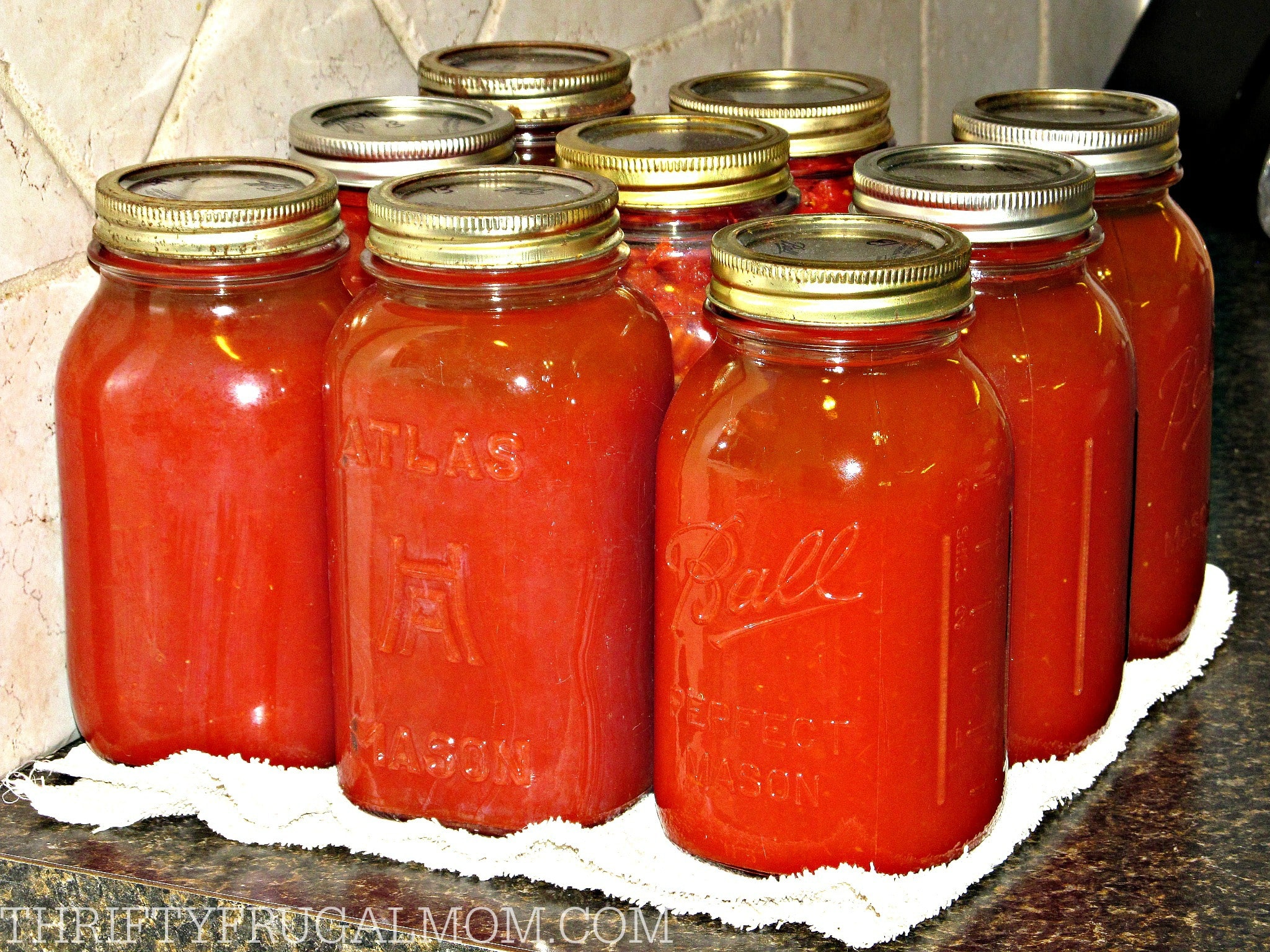Canning Tomato Juice
4.7
(52)
Your folders
Your folders
Author : Lydia @ ThriftyFrugalMom.com

Ingredients
Export 2 ingredients for grocery delivery
Instructions
Step 1
Wash tomatoes thoroughly. Cut out the stem and any defects or blemishes, but there’s absolutely no need to peel them!
Step 2
Cut tomatoes into chunks for quicker cooking, then dump into a kettle.Use your hand (or a potato masher) to squish a few tomatoes in the bottom of the kettle. This helps create enough juice to start cooking the tomatoes without having them stick to the bottom of the kettle.As the tomatoes cook, they will start to juice themselves and you’ll soon have more liquid. Cook on medium heat, stirring several times being sure to move the tomatoes on the bottom to the top for even cooking.
Step 3
Cook until soft, about 10 minutes.
Step 4
At this point, you have several options for turning the cooked tomatoes into juice. I’m going to explain the process I use and then include details for other methods at the bottom of this post in the Notes.Fill the “pan” part of the Food Mill with cooked tomatoes and then turn the handle to juice them. Continue turning, occasionally reversing the direction to clean the tomatoes off the bottom.
Step 5
Once there is basically no tomato juice coming out anymore and you have very little peel and seeds left in the food mill pan (take not of the picture on my blog), discard the scraps.I actually often pour the scraps into a cake pan and after it’s full, I’ll run them all through the food mill again. I like really thick, pulpy juice and I’ve found that by doing this, I get a pulpier juice. But it is definitely just personal preference and you always can toss the scraps immediately if you prefer!
Step 6
Pour the tomato juice into clean canning jars- a wide funnel makes this super easy. The jars should be filled just to the base of the neck.
Step 7
Add Citric Acid (¼ tsp. per pint or ½ tsp. per qt) or bottled lemon juice (1 Tbsp. per pint or 2 Tbsp. per quart) to each jar of tomato juice to create a safe level of acidity.
Step 8
Add ½ tsp. salt per pint and 1 tsp. salt per quart. (optional, but recommended for best flavor)
Step 9
Wipe the rim of each jar with a clean, damp cloth to remove any tomato residue that may be there. (If there is even a slight bit of tomato juice on it, it may not allow it to seal properly.)
Step 10
Once you have 7 jars filled, place 7 metal canning lids in a small pan. Cover with water; bring to a boil. Once the water boils, use a fork or lid lifter to lift the jar lids out of the water and place them on the jars. Be careful not to burn yourself!Secure each lid with a jar band/ring. (Heating the lids softens the rubber, allowing for a better seal, although I read recently that some of the newer lids actually recommend that you don’t boil them, so double check the instructions on your box of lids before doing this step.)
Step 11
Place 7 jars in the canner. Fill the canner with enough hot water to cover the jars by 1 to 2 inches. Turn the burner on medium high heat. Once water starts to boil, reduce heat slightly and process: 35 minutes for pints and 40 minutes for quarts.Make sure the water is boiling gently and steadily the whole time. (You may need to adjust heat to keep the boil going nicely, but really, as long as it is boiling, you are fine.)
Step 12
After processing is complete, turn the burner off. Remove jars using the jar lifter– you may want to have a dishrag in your other hand to catch any hot water that drips from the jars as you remove them- and place on an old towel, blanket or another padded surface. (This protects your countertop from the super hot jars.) Allow at least a little bit of air space around each jar, making sure not to have jars close enough to touch. Do not move jars again until they are completely cool.
Step 13
Jars should seal as they cool and you will typically hear a snap or pinging sound as the vacuum seal is formed. Lids will be slightly concave when sealed.To test the seal, allow the jar to cool completely, then lightly tap the center of the cooled jar lid. If it is firm and does not move, it should be sealed. If it pushes in, it didn’t seal properly. You can still use unsealed jars, just put them in the refrigerator and use them as soon as possible.
Step 14
After jars are completely cool, you can remove the rings. Jars should be wiped clean before storing them.